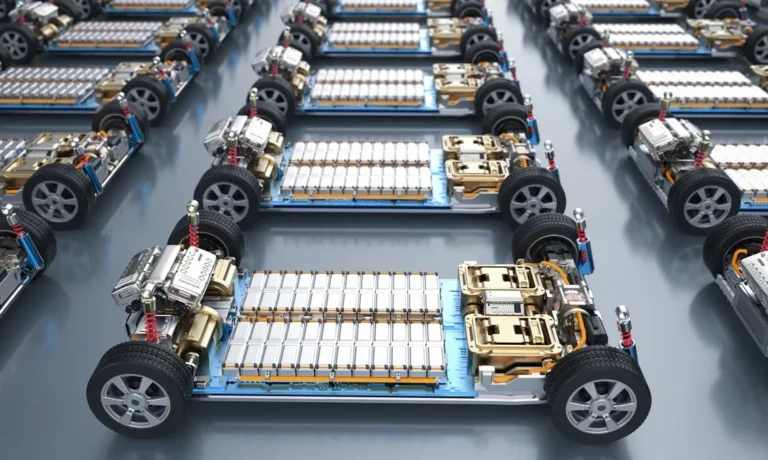Lithium: innovative material discovered for sulphur-free solid batteries

Scientists at the Tokyo University of Science have discovered a stable and highly conductive lithium-ion-based material in the form of pyrochlorochloride-type oxyfluoride that is a candidate to be the next sulfur-free solid electrode that will enable the creation of state-of-the-art batteries. solid. Among other things, these new electrodes do not have the problem of not working in cold climates.
All-solid-state lithium-ion batteries offer greater safety and energy density than their liquid electrolyte counterparts, but face challenges such as lower conductivity and insufficient contact between electrodes.
This type of highly conductive non-sulfurized solid electrolyte paves the way for the production of efficient and durable solid-state batteries. The study was published in Chemistry of Materials with financial assistance from Denso Corporation.
Fully solid lithium-ion (Li-ion) batteries with solid electrolytes are non-flammable and have a higher energy density and transfer rate than those with liquid electrolytes. They are expected to take a share of the market for traditional lithium-ion batteries with liquid electrolyte, such as electric vehicles.
Currently, sulfide-based materials have been used in solid-state lithium batteries that are conductive, reacting with moisture to form toxic hydrogen disulfide. Therefore, there is a need for solid non-sulphurized electrolytes that are conductive and stable in air, to make safe, high-performance and fast-charging solid-state lithium-ion batteries.
The pyrochlore-type oxyfluoride studied in this work can be indicated with a not very simple formula Li2-xLa(1+x)/3M2O6F (M = Nb, Ta). It was subjected to structural and compositional analysis with several techniques, including X-ray diffraction, Rietveld analysis, inductively coupled plasma optical emission spectrometry, and selected area electron diffraction. Specifically, Li1.25La0.58Nb2O6F was developed, which demonstrated a bulk ionic conductivity of 7.0 mS cm?¹ and a total ionic conductivity of 3.9 mS cm?¹ at room temperature.
Lithium ion conductivity was found to be higher than that of known solid oxide electrolytes. The ionic conduction activation energy of this material is extremely low, and the low-temperature ionic conductivity of this material is one of the highest among known solid electrolytes, including sulfide-based materials. For precision, even at -10°C, the new material has the same conductivity as conventional solid oxide-based electrolytes at room temperature. Furthermore, since the conductivity above 100°C has also been tested, the operating range of this solid electrolyte is -10°C to 100°C. Conventional lithium-ion batteries cannot be used at lower temperatures to zero. Therefore, the operating conditions of lithium ion batteries for commonly used mobile phones are 0°C to 45°C.
The conduction mechanism of lithium ions in this material was studied. The conduction path of the pyrochlore-type structure covers the F ions located in the tunnels created by the MO6 octahedra. The conduction mechanism is the sequential movement of Li ions as they change bonds with F ions. Li ions move towards the nearest Li position, always passing through metastable positions. The immobile La3+ bound to the F ion inhibits the conduction of Li ions, blocking the conduction path and nullifying the surrounding metastable positions.
Unlike existing lithium-ion secondary batteries, oxide-based solid-state batteries do not pose the risk of electrolyte leakage due to damage, nor the risk of generating toxic gases as is the case with sulfide-based batteries. Therefore, this new innovation is expected to drive future research.
In particular, the new material is highly stable and does not catch fire if damaged. It is suitable for airplanes and other places where safety is paramount. It is also suitable for high-capacity applications, such as electric vehicles, because it can be used at high temperatures and supports fast charging. Furthermore, it is also a promising material for the miniaturization of batteries, household appliances and medical devices.
According to Prof. Fujimoto, “Making fully solid-state secondary lithium-ion batteries has long been the dream of many battery researchers. We discovered a solid oxide electrolyte that is a key component of all-solid-state lithium-ion batteries, which have high energy density and safety. In addition to being stable in air, the material has higher ionic conductivity than previously reported solid oxide electrolytes."
“The newly discovered material is safe and has higher ionic conductivity than previously reported solid oxide-based electrolytes. The application of this material is promising for the development of revolutionary batteries that can operate in a wide range of temperatures, from low to high,” predicts Prof. Fujimoto. “We believe that the performance requirements for the application of solid electrolytes for electric vehicles are met.”

Thanks to our Telegram channel you can stay updated on the publication of new Economic Scenarios articles.
The article Lithium: innovative material discovered for sulphur-free solid batteries comes from Scenari Economici .
This is a machine translation of a post published on Scenari Economici at the URL https://scenarieconomici.it/litio-scoperto-innovativo-materiale-per-le-batterie-solide-senza-zolfo/ on Fri, 10 May 2024 08:00:11 +0000.
